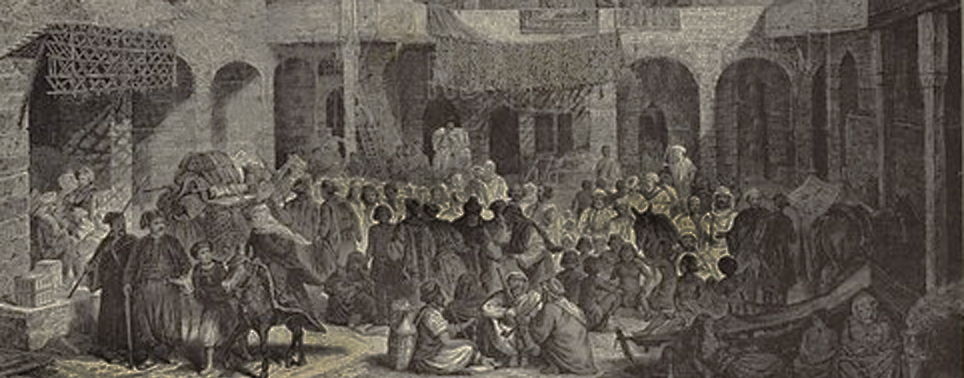From midway through the sixteenth century until the early nineteenth, tens of thousands of people were taken captive by Barbary corsairs from Algiers and brought to that city, where they were auctioned off to the highest bidder in the Badestan—the market where slaves were bought and sold.
The word “Badestan” is a European rendering of the Ottoman Turkish word “Bezistân” (from “bez,” meaning canvas or cloth, and “stân,” the familiar suffix employed to indicate place). The word was used generally throughout the Middle East to refer to a covered market—also referred to as a souk in Arabic. Every Ottoman city of any size had its Bezistân. Generally, a city’s Bezistân was the place where expensive, precious, or luxury items were sold (there were separate markets for more pedestrian commodities such as livestock, grains, fruits, cloth, leather goods, household objects, etc.).
The most famous Bezistân was in Istanbul. Nicolas de Nicolay, who traveled to Istanbul in the early 1550s as a member of an embassy from the French King Henry II to the Ottoman Sultan Suleiman the Magnificent, visited the Istanbul Bezistân and left us this description:
_____
The place called the Bezistân is large, square, and high. It is constructed as a covered hall, with four gates and laneways within it, with shops lining it furnished with all sorts of rare and expensive merchandise such as rings, precious stones, furs of martins, sables, wolves, deer, foxes, and others… all sorts of cloth of gold, of silver, of silk…Turkish bows, targets and bucklers, and other merchandise very rich and opulent. And there are also sold there, to those who bid the most for them, an infinite number of Christian slaves of all ages and both sexes. They are sold as we sell horses, for those who wish to buy these slaves view their eyes, their teeth, and the whole of their body, and even cause them to be stripped naked and watch them move about so that the buyers might better know the defects of nature that might be in them or the imperfections of their persons, a thing most pitiful and lamentable to behold. I saw there a Hungarian girl of thirteen or fourteen years of age, of indifferent beauty, who, in one of the corners of the Bezistân, was stripped and examined three times in less than an hour, and who, in the end, was sold and delivered to an old Turkish merchant for the sum of thirty-four ducats.
_____
The Badestan in Algiers was no doubt similar to the Bezistân in Istanbul, both in function and form, since there was a certain generic commonality to such covered markets, and the above description probably fits it quite well: a walled-in rectangular space filled with shops selling all manner of goods—including human beings.
There are some brief descriptions of the Badestan in the narratives written by captives in Algiers.
Reverend Ólafur Egilsson, an Icelandic pastor who was in Algiers in the summer of 1627, describes it as: “a square built up of stones with seats encompassing it all around, paved with stones which appeared glossy because they were washed every day.” Laurent d’Arvieux, who was the French consul in Algiers in the 1670s, described the Badestan as “a long and wide street, closed at both ends, where everything from the prizes the corsairs bring in is sold.” Cornelis Pijnacker, a Dutch Special Envoy who was in Algiers in the 1620s, visited the Badestan and described it as “a square, not very big, and longer than wide, about eighty or a hundred feet long and half that wide” (about 24 to 30 meters long and 12 to 15 meters wide).
Putting the details from these various sources together, we can come up with a composite description of the Algiers Badestan: it was an enclosed rectangular space, likely at least partially covered over, close to 100 feet long by 50 feet wide (30 meters by 15 meters), with a flagstone pavement underfoot, lined with shops on all sides. There were far more things being sold there than just human beings, and it would have been a crowded, noisy, bustling place.
Newly arrived captives in Algiers would typically be housed for several days (sometimes a week or two) before being taken to the Badestan to be sold. Numerous descriptions of the sales process have survived, and we can recreate it in considerable detail from first-hand accounts.
For a description of what it was like to be sold into slavery in the Badestan, see the next post in this series: The Algiers Slave Market: Part 2.
 The Travels of Reverend Ólafur Egilsson
The Travels of Reverend Ólafur Egilsson
The story of the Barbary corsair raid on Iceland in 1627
Amazon listing